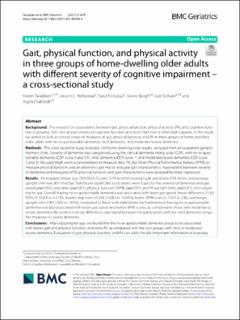| dc.description.abstract | Background: The research on associations between gait, physical function, physical activity (PA), and cognitive function is growing. Still, clinical assessments of cognitive function and motor function is often kept separate. In this study, we aimed to look at a broad range of measures of gait, physical function, and PA in three groups of home-dwelling older adults with no or questionable dementia, mild dementia, and moderate/severe dementia.
Methods: This cross-sectional study included 100 home-dwelling older adults, recruited from an outpatient geriatric memory clinic. Severity of dementia was categorised using the clinical dementia rating scale (CDR), with no or questionable dementia (CDR score 0 and 0.5), mild dementia (CDR score 1) and moderate/severe dementia (CDR score 2 and 3). We used thigh worn accelerometers to measure daily PA, the Short Physical Performance Battery (SPPB) to measure physical function, and an electronic gait mat to evaluate gait characteristics. Associations between severity of dementia and measures of PA, physical function, and gait characteristics were assessed by linear regression.
Results: Participants’ (mean age 78.9 (SD 6.7) years, 57% women) average gait speed was 0.93 m/sec, and average upright time was 301 min/day. Statistically signifcant associations were found for the severity of dementia and gait speed (p=0.002), step time (p=0.001), physical function (SPPB, p=0.007), and PA (upright time, p=0.031), after adjusting for age. Overall, having no or questionable dementia was associated with faster gait speed (mean diference 0.163 (95% CI: 0.053 to 0.273)), shorter step time (-0.043 (-0.082 to -0.005)), better SPPB score (1.7 (0.5 to 2.8)), and longer upright time (78.9 (18.9 to 139.0)), compared to those with mild dementia. Furthermore, having no or questionable dementia was also associated with faster gait speed and better SPPB scores, as compared to those with moderate to severe dementia. No evidence of any diferences was found between the participants with the mild dementia versus the moderate to severe dementia.
Conclusions: After adjusting for age, we found that the no or questionable dementia group to be associated with better gait and physical function, and more PA, as compared with the two groups with mild or moderate/severe dementia. Evaluation of gait, physical function, and PA can add clinically important information of everyday functioning in memory clinics meeting geriatric patients, but investigations on how to use these results to guide interventions are still needed. | en_US |

